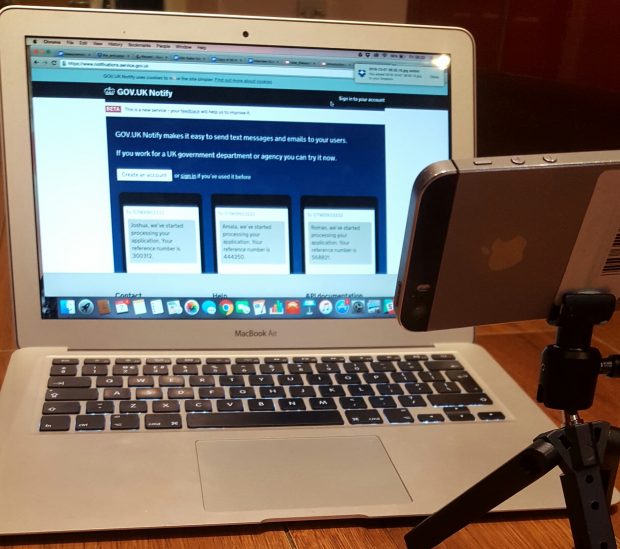Hello, I’m a user researcher on the GOV.UK Notify team. For the past couple of months I have been doing research with developers to see how easy it is to integrate Notify with their services, and streaming the sessions back to my team.
I found it difficult to recruit participants to attend usability sessions in the lab at Aviation House, in part because it’s quite a big time commitment to ask of them. So I decided to go to the users instead.
This kind of contextual research is incredibly useful, but it does run the risk of your team missing out on observing users. Lab sessions are valuable because your team can see for themselves how users use the product. It's also easier to get people to the lab for a session as the research is happening rather than asking them to watch a video at their desk later when they’re busy. I really wanted my team to still be a part of research in this way, so I decided to try and stream the action in Leeds back to the lab in London.
The kit was simple: I used a phone, a phone stand, and connected to the wifi to do a Google Hangout from the phone with our lab manager back at Aviation House. I pointed the phone at the participant’s laptop screen and everyone in our lab observation room in London could then see what was happening.

Setup for streaming remote research
The first time I did this, it worked surprisingly well. The technical setup at the government building I was visiting was excellent, meaning my team got a nice clear picture and good audio. The second time we had multiple tech issues, meaning it didn’t go so well.
Here are some things I’ve learned about making streaming as painless as possible.
Take a mobile wifi device
I was visiting various government departments, and some of them have restricted wifi that I couldn’t access. Equally if you are at someone’s home or a public place it might not be easy to get online either. This is why I recommend taking a mobile wifi device to mitigate any internet access problems. At the very least, ask beforehand if there are any restrictions or wifi setup processes that you need to do in advance.
Check for any firewall restrictions
The great thing about contextual research is that users can use their own devices. However, those devices might be locked down. In the research I did, participants were required to download something from Github but sometimes weren’t able to because of their machine firewall restrictions. It’s good to check for anything like that which might prevent them from completing a task.
Make life simple for yourself
The second time I did this research I arranged sessions in three different locations in one day. That was a mistake! It meant I had three different technical setups to wrangle with, which makes things unnecessarily stressful. Stay in one location wherever possible.
Prep your observers
If you’re doing research away from the lab it can feel like it’s not something the rest of the team needs to get involved in. However, we know it’s important for everyone to observe users. To keep everyone on board, prep your team beforehand to let them know you’re trying out a new approach, but you still really need them to come along to a session and observe and take notes.
Don’t be afraid to try new things
It was a little daunting trying this out the first time, but it’s actually exciting to mix up the research sometimes and try new methods. I’m going to be doing more of this in the future, and I would love to know if anyone else is doing this and what tips they have. Do comment below.
Keep in touch. Sign up to email updates from this blog. Follow Katie on Twitter.
3 comments
Comment by Andrew Muir Wood posted on
Have you discovered Live Hangouts on YouTube? You can stream the research live to a YouTube link and save the recording on the same link for viewing afterwards.
You can also crop the video in YouTube so it saves edit time and limit the audience to certain email addresses.
Comment by Katie Valentine posted on
Thanks Andrew, I haven't used it before but I'll take a look.
Comment by Avril posted on
Hi Katie, were you also recording the session to review after the session?
If you did, I would be interested to know how you did this (what software you were using).
I have found a few issues when trying to record and share the session with others remotely at the same time eg. the sound gets hijacked by one bit of software meaning we lose sound either for those viewing remotely or on the recording of the session.
Have you come across this?
I'd love any tips on avoiding this problem .
Thanks,
Avril